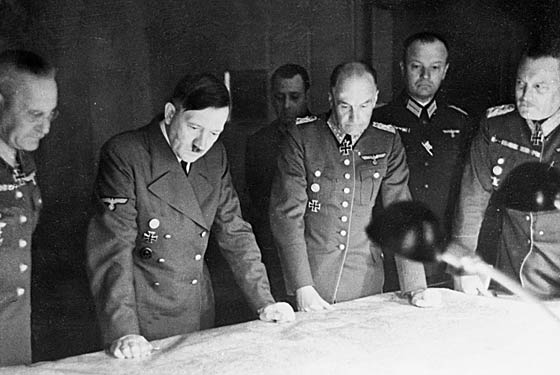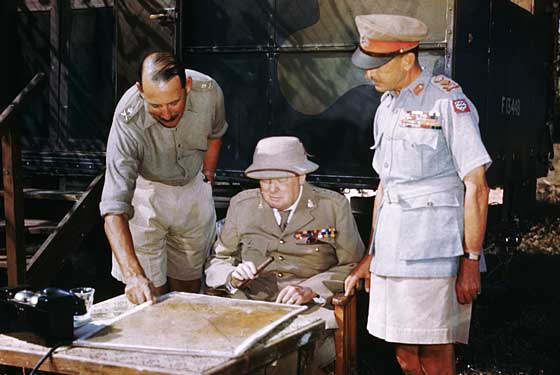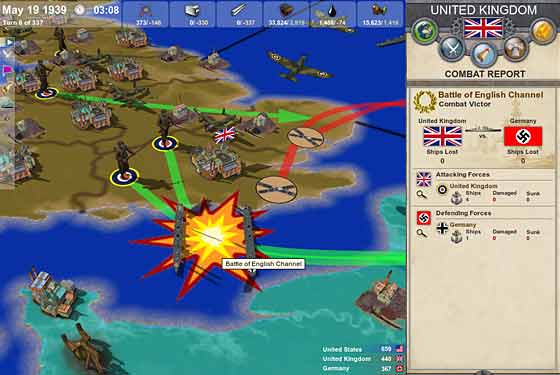
All my life I have played va banque [go for broke],” said Hitler. Churchill too was a gambler, once literally deluging his wife with his casino winnings. Eisenhower preferred the bridge table. For Homo ludens (“playing man,” a phrase coined by the Dutch historian Johan Huizinga in 1938), war is the great game and World War II was the greatest game of them all.
My sons, ages 7 and 12, play these games compulsively. For a while, their GameCube favorite was Medal of Honor: Allied Assault. Then they discovered Call of Duty. The latest fad is Soldiers: Heroes of World War II, which they play online on their PCs.
To say that I’m interested in World War II would be an understatement. For the past few years, I have been toiling to write its history, skulking in my study and neglecting my children in the process. In theory, games like Medal of Honor ought to have helped our family to reconnect when I finally emerged from my books. But no. Unfortunately—and to the disappointment of my sons—I hate them. And that’s despite the fact that I sincerely believe computer games have a potentially revolutionary role to play in the teaching of history.
I’ll go further. There’s never been a more important time for people to play World War II games. For the last five years, politicians from the president down have been recycling the rhetoric of that conflict. September 11 was “a day of infamy.” Saddam/Ahmadinejad/Kim Jong Il is the new Hitler. And yet few of these politicians seem to have any real understanding of the strategic risks involved in global conflict.
So why do I hate Medal of Honor? The trouble is—and the same could be said of nearly all its competitors—it’s profoundly unhistorical. It’s what’s known in the games trade as a first-person shooter (FPS) game. As a player, you take on the role of Lieutenant Mike Powell of the U.S. Army Rangers. You see the battlefield—a Normandy beach, for instance—from his vantage point. As Lieutenant Powell, you do pretty much what you feel like—which is to bag as many Germans as you can. In reality, an officer’s principal concern on Omaha Beach was somehow to maintain the cohesion of his unit in the face of a lethal storm of steel.
Second, the cost of a miscalculation is low. Wounds merely deduct points from your “health.” Death—usually and rather grotesquely signaled by a grunt and the descent of a red mist over the screen—simply means the end of one game and the start of the next.
In fairness, games like Medal of Honor, Call of Duty, and Soldiers have taught my sons an amazing amount about World War II hardware. But at root, they’re just playing Space Invaders—make that Beach Invaders—with fancy graphics.
Part of the problem may be the games’ unconscious anachronism—many of them are inspired, if not directly based, on software recently developed by the U.S. military for training purposes.
If you want to see the future of the war-games industry, it’s a good idea to check out the annual conference of darpa (the Defense Advanced Research Projects Agency) or to monitor the latest output of the Army’s Program Executive Office for Simulation, Training and Instrumentation. The problem is that the situations the Army wants to simulate today are very different from the ones experienced by soldiers in the early forties.
To the historian, in any case, tactics and the individual soldier’s battlefield experience are only some of the war’s many facets. Of more importance by far is the question of strategy. D-day was a decisive Allied victory, but not a preordained one. On the eve of the operation, Eisenhower was sufficiently conscious of the risks involved to draft the statement he would issue in the event of its failure.
“What if D-day had gone wrong?” is only one of scores of counterfactual questions historians have asked about the war. What if the Nazis had invaded Britain in 1940? What if Hitler had captured Moscow in 1941? What if the Japanese had won the Battle of Midway in 1942? These are questions that computer games ought, in theory, to be able to help answer. And yet no military historian, to my knowledge, has made use of them. This is doubly surprising. Not only is there a long and respectable tradition of war games within the military academy, but games also played a central role in Cold War strategy, advancing an entire branch of mathematics—game theory—in the process.
But Cold War games are now obsolete. Then, there were just two players, each armed to the teeth with nukes. Today we live in a multipolar, multiplayer world. Some players are much better armed than others. In that sense, today’s strategic problems are more like those of the World War II era. Sure, the U.S. can invade Iraq. But what will the French do? The Russians? The Chinese? What if invading Iraq ends up benefiting Iran? The question is, where to learn this kind of stuff? Sure, there are already some games that offer World War II scenarios. But Civilization and Empire Earth, to take perhaps the best-known examples, are not what the historian needs, since what they provide is such a crude caricature of the historical process. In both games, the player quickly learns that it is prudent to build up one’s economic capabilities before embarking on a war. But this is a universal truth, as valid for Julius Caesar as for Benito Mussolini. Behind the graphics, neither game tells you much about the specifics of 1939 to 1945. The warring sides therefore might as well be hobbits and orcs or teenage wizards and dementors.

Up until now, the best my sons and I could do when it came to replaying World War II was in fact an old-fashioned board game, Axis & Allies. Similar in its mode of operation to the earlier strategy game Risk, Axis & Allies offers a reasonable approximation to the strategic position in 1942. But I stress approximation. The game vastly understates the economic power of the United States, for example. The best thing about Axis & Allies is that battles are decided by a combination of firepower and luck. Dice are thrown, but the odds are weighted in favor of the player with the most men and hardware. (Each time I play, I’m impressed by the calibration of these weightings.) Luck did matter in the war; Pearl Harbor would have been a much bigger disaster if the American aircraft carriers had not been absent on maneuvers; the success of D-day was heavily dependent on the weather. But luck mattered only within limits set by what Stalin liked to call the constellation of forces. In Axis & Allies, it is clearly possible for the Axis powers to win, provided they strike quickly against badly led Allies. I know this because I watched my elder son, in the role of Hitler, trounce me the first time we played the game. But did this convince me that the real Hitler could have won the war? Or did it just mean that my son got lucky? Good though it is as a board game, Axis & Allies is still a very long way from historical reality. Which is why I’m so glad I discovered Making History: The Calm & the Storm, a pioneering computer game devised by Muzzy Lane, a software company in Newburyport, Massachusetts.
Based on a combination of system dynamics, a technology designed to generate simulated scenarios from real-world data, The Calm & the Storm has a completely different feel from any other war game I’ve played. To begin with, it is based on a quite astonishing quantity of factual information about the war.
Like Axis & Allies or Civilization III, the graphic interface is a map. But the level of detail is quite unique. Not just national borders but provincial borders are visible. And all the world’s countries are depicted; players can choose from up to eleven governments, including China’s.
And the balance between military capability and economic resources is represented in a far more sophisticated way than I’ve ever seen. Play the part of Britain in September 1938—during the crisis over Czechoslovakia—and you quickly discover (as historians have long maintained) that Britain’s pace of rearmament cannot be accelerated.
Other games reduce war to a crapshoot. This game makes it clear that strategy is about diplomacy as well as pitched battles. If you use the first of the currently available scenarios in The Calm & the Storm, “The Politics of Appeasement,” you have the option of trying to avoid war altogether, seeing if you can do better than Neville Chamberlain. Alternatively, you can do what I did: implement a Churchillian strategy aimed at fighting Germany sooner rather than later. We call this preemption nowadays.
I argue in my new history that confronting Hitler in 1938 would have paid handsome dividends. Even if it had come to war over Czechoslovakia, Germany would not have won. Germany’s defenses were not yet ready for a two-front war. So how did my preemptive strategy stand up to a computer stress test? Not as well as I had hoped, I have to confess. The Calm & the Storm made it clear that lining up an anti-German coalition in 1938 might have been harder than I’d assumed. To my horror, the French turned down the alliance I proposed to them. It also turned out that, when I did go to war with Germany, my own position was pretty weak. The nadir was a successful German invasion of England, a scenario my book rules out as militarily too risky.
That’s not to imply that the game is weighted in Germany’s favor. When I switched roles and became the German dictator for a day, things went even worse. In my book, I consider various ways in which Hitler might conceivably have won the war. One obvious scenario imagines Hitler not attacking Western Europe but taking on the Soviet Union straight after Poland. I tried this, aiming to defeat Poland and then launch an early Operation Barbarossa in 1940. But I made a fatal mistake. I decided to dispense with the Nazi-Soviet pact and defeat Poland single-handed. It didn’t work. And as soon as things began to go wrong, I found myself entirely alone. By the end of the game, Berlin had fallen and the whole of Eastern Europe was in Stalin’s hands. I had discovered, in short, that unilateral action can lead to disastrous isolation.

Reeling from my catastrophic failure to improve on Hitler’s strategy, I called up Dave McCool, the president of Muzzy Lane. Had he ever won as Germany? Yes, he had.
“I was playing as Germany and attacked Poland in the spring of 1939,” he told me in an e-mail debriefing. “The western Allies did not intervene, so I was able to finish off Poland and not have a western front to worry about. I spent some time building up my forces and deploying along the Soviet frontier. When my forces were about two-thirds the size of the Soviets, I attacked in the center and the north along the Polish-Soviet frontier.
“Things quickly turned into a couple of big attrition battles in the center and the north, with both sides feeding troops in to keep from losing. After many turns of this I noticed that they had left things pretty bare in the south, so I diverted my new troops there and pushed through. I was able to send armored divisions into the Caucasus and capture the oil fields, while turning my other forces north and cutting off the big battles we were fighting.
Today’s strategic problems have world War II analogues. Sure, the U.S. Can invade Iraq. But what will the French do? The Russians? What if invading Iraq ends up benefiting Iran?
“With him out of supply and unable to reinforce, the battles tipped in my favor and I was able to destroy most of his forces in the west. From that point on it was a matter of slogging east and hunting down the rest. The USSR surrendered in the summer of 1941.”
Now ask yourself: How many other companies in the world are run by a man who has led Germany to victory in World War II?
Of course, no one at Muzzy Lane pretends that their game precisely replicates the world in 1938 or 1939. Nevertheless, the parallel pasts the game conjures up have an undoubted intellectual value—which is why McCool and his partners have hitherto concentrated their energies in marketing their product to educators.
I too can readily imagine the value The Calm & the Storm would add to an undergraduate course on World War II. Indeed, I can hardly wait to set up a game-based seminar at Harvard, having heard one group of students last term hold an impromptu and high-octane discussion on the historical merits of Axis & Allies.
My sons were in no doubt that The Calm & the Storm was more challenging than their favorite FPS games. However, when I suggested that this should be regarded as an alternative to their usual history homework, rather than as an alternative to Grand Theft Auto, they were filled with enthusiasm. I have no doubt they’d learn more from playing a game like this than from any school-textbook assignment.
Muzzy Lane is already planning games that will be based on other conflicts ranging from the American Revolution through the Cold War to the present war in Iraq. Just imagine: Instead of Monday-morning quarterbacks pontificating vaguely about how they could have cleaned up the Iraq mess with a few thousand extra troops in 2003, we will be able to replay the post-9/11 crisis as a carefully calibrated game of diplomacy, strategy, and counterinsurgency. Those who have found it so easy to heap scorn on the Bush administration may well be vindicated. Or they may discover—as I did when I played the parts of Churchill and then Hitler—that there were worse possible outcomes than the one we know. That’s obviously true in the case of the Cold War. Two players less coolheaded than Kennedy and Khrushchev could easily blow the world apart over Cuba.
Gaming history is not a crass attempt to make the subject relevant to today’s kids. Rather it’s an attempt to revitalize history with the kind of technology that kids have pioneered. And why not? After all, the Game Boy generation is growing up. And, as they seek a deeper understanding of the world we live in, they may not turn first to the bookshelves. They may demand to play—or rather replay—the great game of history for themselves. And who knows? When they come to make real strategic decisions, maybe this strategically savvy generation will do a better job than we did.
Axis Action
What’s the best way to refight the last war? A historian rates the games.
CIVILIZATION III
The tried-and-tested format can be applied to World War II, but the resemblances are superficial and lacking in historical content.
MEDAL OF HONOR
Allied Assault: The best of the FPS games, but don’t be deluded into thinking you’re learning anything meaningful about D-day.
AXIS & ALLIES
The best of all the war board games, remarkable for the insights it provides into the big strategic questions of the war. Still, oversimplifying in many ways, if not downright misleading.
THE CALM & THE STORM
Challenging in its complexity and the depth of detail it offers, this is the nearest thing I’ve encountered to a historically credible computer game. Even experts will be forced to rethink their assumptions about the war.